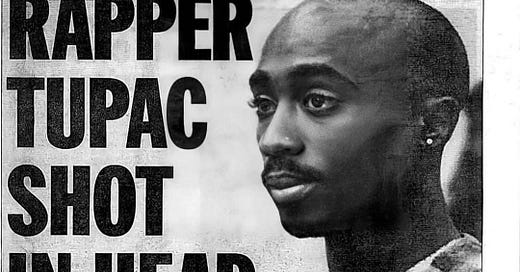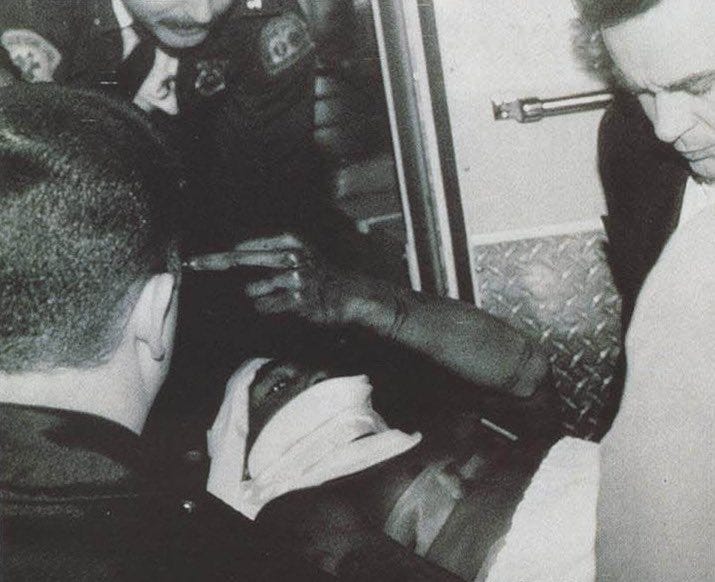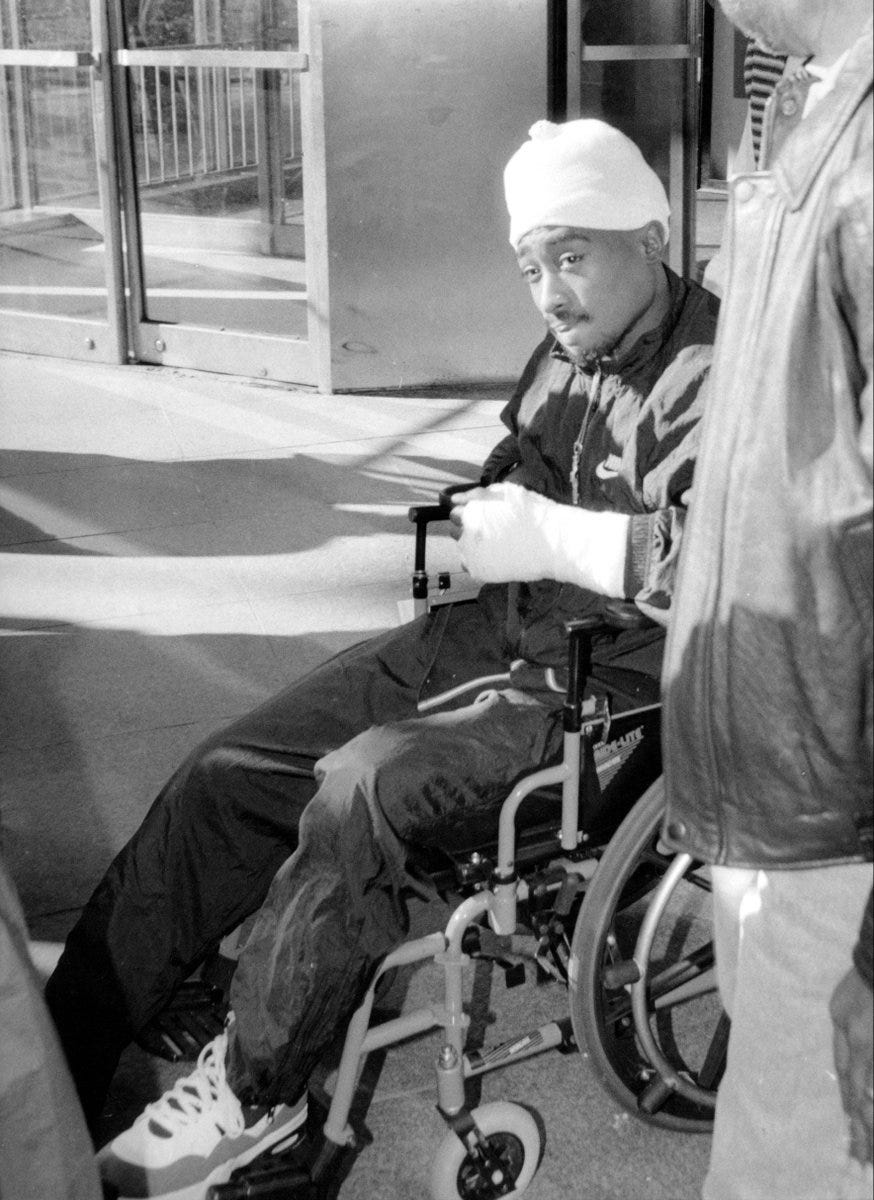The Quad Recording Studios Incident: Tupac Shakur's Transformative Moment in Hip-Hop History
The 30th Anniversary of Tupac Shakur Shot and Robbed in Quad Studios
On this date in 1994, the late rapper Tupac Shakur (2Pac) was in Harlem, New York, recording verses for a mixtape of Ron G. He was repeatedly distracted by his beeper. Music manager James “Jimmy Henchman” Rosemond reportedly offered 2Pac $7,000 to stop by Quad Studios in Times Square that night to record a verse for his client Little Shawn. 2Pac was unsure but agreed to the session as he needed the cash to offset legal costs.
2Pac headed into the building on 7th Avenue in Manhattan that houses Quad Recording Studios. He was accompanied by his manager, Freddie Moore, and his friend, Randy “Stretch” Walker, of the Live Squad, just one day after the jury’s deliberation in his rape case. As Tupac and his crew approached the elevator, three gunmen confronted them and demanded their money and jewelry. While Moore and Walker complied with the demands, 2Pac began to curse at the assailants, which led to him being shot five times and robbed of approximately $40,000 worth of jewelry before Walker managed to drag him into the elevator to safety. 2Pac later speculated that the shooting might have been a set-up.
Against medical advice, 2Pac left the Metropolitan Hospital Center a few hours after his surgery and went to recuperate at the home of actress Jasmine Guy. The following day, he appeared at a Manhattan courthouse in a wheelchair and bandaged to receive the jury’s verdict in his sexual abuse case. For the next several weeks, Shakur was cared for by his mother and a private doctor at Guy’s home, with the Fruit of Islam and former members of the Black Panther Party standing guard to protect him.
The Cultural Impact of the Quad Studios Shooting
The 1994 shooting of Tupac Shakur at Quad Recording Studios had a profound and lasting cultural impact on hip-hop. This event altered the trajectory of Tupac’s career and served as a pivotal moment in the genre’s history, shaping the narratives and themes explored in hip-hop music and culture.
1. Shift in Lyricism: Tupac’s lyrics became increasingly reflective and politically charged after the shooting. He addressed themes of violence, betrayal, and survival, reflecting on his personal experiences and the harsh realities of street life. This shift influenced many artists to adopt a more raw and authentic approach to their music, leading to a hip-hop storytelling trend that conveyed real-life struggles.
2. East Coast vs. West Coast Rivalry: The incident intensified the rivalry between East Coast and West Coast hip-hop scenes, especially between artists and labels. Tupac’s affiliation with Death Row Records and his subsequent feud with Biggie Smalls and Bad Boy Records further fueled tensions, giving rise to an era defined by regionalism that impacted relationships within the industry and led to legendary diss tracks.
3. Media Representation: The media’s portrayal of Tupac’s shooting and the surrounding events contributed to a narrative that often depicted rap artists as violent and troubled figures. This sensationalism influenced public perception of hip-hop, leading to stereotypes affecting artists today. The incident highlighted the relationship between hip-hop culture and media, forcing artists to navigate their public personas carefully.
4. Legacy of Violence: Tupac’s shooting and later death in a drive-by shooting in 1996 raised awareness of the dangers that artists faced. It sparked discussions about violence in the hip-hop community, the impact of socioeconomic factors, and the need for artists to address these issues within their work. The legacy of his death remains a cautionary tale in the industry.
5. Influence on Future Generations: Tupac’s experiences and the events surrounding his shooting have influenced countless artists who followed him. His ability to weave personal narratives into his music has inspired a generation of rappers to be more open about their struggles, mental health, and societal issues. Artists like Kendrick Lamar and J. Cole often cite Tupac’s work as a primary influence in their music, showcasing the enduring impact of his legacy.
6. Cultural Reflection and Activism: Ultimately, the Quad Recording Studios shooting reflected broader societal issues, including systemic racism and violence in urban communities. Tupac’s responses in the aftermath connected him to a more significant movement for social justice, encouraging others in hip-hop to use their platforms for activism and change.
In summary, the shooting at Quad Recording Studios marked a crucial turning point in hip-hop that reverberated through the genre’s evolution, influencing its themes, the relationships between artists, and the more significant cultural conversations surrounding violence, race, and authenticity in music.
The Legacy of the Quad Studios Shooting
The legacy of the Quad Studios shooting on Tupac Shakur is a multifaceted narrative that has significantly influenced hip-hop culture, shaping artists and the industry in numerous ways.
1. Transformative Lyricism
After the shooting, Tupac’s music took a notable turn toward introspection and social commentary. His lyrics began to reflect themes of violence, struggle, and resilience. This shift resonated with his audience and inspired a generation of artists to embrace authenticity in storytelling, fostering a raw, unfiltered approach to lyricism in hip-hop.
2. Heightened Rivalries
The incident exacerbated the notorious East Coast vs. West Coast rivalry, drawing clear lines between artists and labels. Tupac’s involvement with Death Row Records and his conflict with figures like Biggie Smalls exemplified this divide, leading to a tumultuous period characterized by fierce diss tracks and heightened animosity. This rivalry shaped the competitive landscape of hip-hop and had lasting impacts on collaborations and relationships within the industry.
3. Media Representation
The coverage of Tupac’s shooting fueled a media narrative that often portrayed rap artists as violent or troubled. This sensationalism played a significant role in shaping public perception of hip-hop culture. The portrayal often overlooked the social issues and personal stories behind the music, leading to stereotypes that continue to challenge artists today.
4. Awareness of Violence
The shooting also brought to light the harsh realities and dangers faced by hip-hop artists. Tupac’s experiences underscored the intersection of socioeconomic factors, crime, and the struggles within urban communities. His subsequent death in 1996 further marked the discussion of violence in the industry, fostering a cautious reflection among artists about the potential consequences of fame and rivalry.
5. Inspiration for Future Artists
Tupac’s legacy as a figure who navigated personal struggles and societal issues has left an indelible mark on younger generations of artists. Rappers like Kendrick Lamar and J. Cole often cite Tupac as a significant influence, inspired by his lyrical depth and willingness to address complex themes such as mental health, identity, and social justice.
6. Cultural and Social Reflection
Ultimately, the events surrounding the Quad Studio shooting serve as a poignant reminder of broader societal issues, including systemic racism and violence within urban communities. Tupac’s responses and the activism that emerged in hip-hop highlight the genre’s potential as a platform for social change, encouraging artists to leverage their voices for justice and reform.
Conclusion
The Quad Studio shooting was not merely an event in Tupac Shakur’s life but a transformative moment in hip-hop history. Its repercussions can be seen in the genre’s evolution, the relationships among artists, and the ongoing dialogue about violence, race, and authenticity in music. The legacy of this incident continues to influence hip-hop culture, underscoring the complexities that define the art form and its artists.






